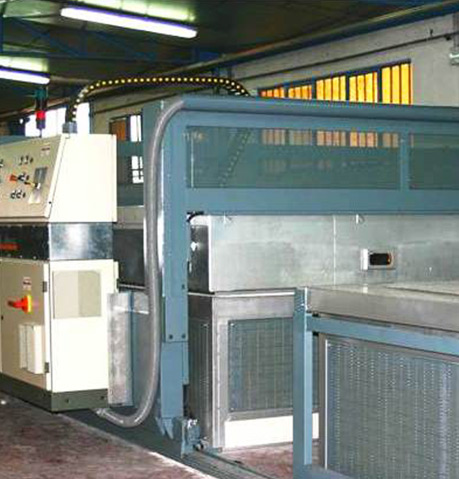TC
INDUSTRIAL GLASS CHEMICAL TEMPERING OVEN
Ctm Srl, working in glass field for a long time, proposes plants for the treatment of glass chemical tempering. The process is done at temperatures that do not cause optical deformation.
Ctm Srl, working in glass field for a long time, proposes plants for the treatment of glass chemical tempering. The process is done at temperatures that do not cause optical deformation.
PROCESS
Glasses, loaded into a special rack are first pre-heated in thermo regulated oven able to move in special rail system , and then dipped into melted salt bath at 450° C where ionic exchange takes place.
The smaller ionium particles (contained in glass) are exchanged with the larger ones (contained in salt).
The major volume of salt ions compresses the superficial layer of glass increasing its resistance.
Thickness differences do not influence the result. The internal layer of the glass does not participate in the exchange which only involves a thin superficial layer having a uniform thickness.
At the end of tempering treatment that last from 16 hrs till 36 hrs, glasses are positioned into the thermo regulated oven to have a controlled cooling phase and subsequently translated to unloading zone and then washed in order to remove all excess salt particles.
ADVANTAGES
- No optical distortion.
- Uncomplicated treatment application.
- Glasses in different colors, shapes, thicknesses can be simultaneously tempered in the same bath.
- Result repeatability is excellent-glasses are guaranteed to be "impact resistant".
- Even glasses less than 3 mm. thick can be hardened.
- Glasses chemically tempered can be edged at the grinding wheel without risk of breakage.
- Loss of resistance from this procedure can be recovered through a rapid tempering cycle.
- More surface resistance to oxidation.
CHARACTERISTICS
Chemical Tempering of Glass is achieved by immersing the glass to be treated in a potassium salt bath at temperatures in excess of 400°C, producing an exchange between the sodium ions (Na+) in the surface of the glass and the potassium ions (K+) in the salt. This ion exchange of potassium (K+) with its larger dimensions in place of sodium (Na+) of smaller diameter, establishes a compressive stress where this takes place: at the surfaces and edges of the sheet. These forces are compensated for by internal tensile stresses present within the glass. As a matter of fact chemical tempering produces higher surface stresses and lower internal stresses than thermally tempered glass: the surface stresses obtained in the
case of chemically tempered glass mean a notable increase in resistance to flexing, one of the main requirements of such a product. The properties of mechanical resistance to flexing of a chemically tempered glass are approximately 5 to 10 times higher than those of a thermally tempered glass subjected to the same forces. This special production process also increases resistance to impact: a thermally tempered glass has a resistance to impact, with a steel sphere, approximately twice that of normal glass, the resistance of chemically tempered glass exceeds that of normal glass by some 5 times.
WHY
Chemical Tempering becomes necessary in the following situations:
- when the thickness of the glass to be tempered is less than 3 mm (difficult to carry out with thermal tempering);
- when we want to achieve a mechanical resistance superior of a thermal tempering;
- when we need to maintain optimum optical properties;
- when we want to obtain glasses with complex bending, different colours and thickness;
- when we want to obtain more oxidation resistance on glass surface.
According to its particular strengthening process the chemically tempered glass has to be laminated to grant compliance to the security standards
- Glass chemical tempering
| MODEL TC |
GLASS DIMENSIONS (UTILIZATION 50%) | POWER | OVERALL DIMENSIONS | SALT Q.TY | ||||
| VERSION "S" | a | c | b | KW | P | H | L | TON. |
| TC/S MC 0,5 | 500 | 800 | 1000 | 60 | 3000 | 3800 | 7500 | 1 |
| TC/S MC 1 | 650 | 1000 | 1500 | 80 | 3300 | 4200 | 9000 | 2 |
| TC/S MC 2 | 800 | 1250 | 2000 | 120 | 3600 | 4700 | 11000 | 4 |
| MODEL TC |
GLASS DIMENSIONS (UTILIZATION 50%) | POWER | OVERALL DIMENSIONS | SALT Q.TY | ||||
| VERSION "M" | a | c | B | KW | P | H | L | TON |
| TC/M MC 4 | 1000 | 1500 | 2500 | 180 | 4000 | 5200 | 12500 | 8 |
| TC/M MC 6 | 1250 | 1500 | 3000 | 220 | 4500 | 5700 | 14000 | 12 |
| TC/M MC 10 | 1300 | 1750 | 3250 | 360 | 5000 | 6200 | 15000 | 20 |
| MODEL TC |
GLASS DIMENSIONS (UTILIZATION 50%) | POWER | OVERALL DIMENSIONS | SALT Q.TY | ||||
| VERSION "X" | a | c | b | KW | P | H | L | TON |
| TC/X MC 14 | 1750 | 1750 | 3500 | 420 | 5500 | 6200 | 17000 | 28 |
| TC/X MC 20 | 2000 | 2500 | 3500 | 480 | 3300 | 7200 | 17000 | 40 |
| TC/X MC 28 | 2500 | 2500 | 4000 | 520 | 3600 | 7200 | 20000 | 56 |










